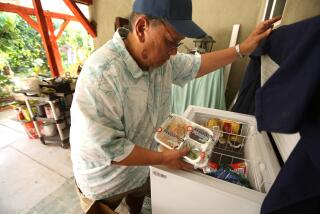L.A. Medical Assn. OKs Guidelines Widening Right-to-Die Decisions
- Share via
Broad, new right-to-die guidelines, including advice on when food and water can be withheld from a terminally or seriously ill patient, were approved Monday night by the council of the Los Angeles County Medical Assn.
The guidelines are designed to help physicians and patients and their families decide when life-sustaining treatments can be withheld or withdrawn without involving the courts.
“They were approved unanimously, without discussion,” an association spokesman said.
The treatments covered in the 11-page document range from the use of antibiotics and blood transfusions to kidney dialysis, mechanical ventilation and intensive care.
The guidelines state that food and water are no different than other life-sustaining treatments. In appropriate circumstances, “it is legally acceptable for the care giver to withhold or withdraw any or all of them,” the document states. The new guidelines are more detailed and comprehensive than existing ones that focused on the discontinuation of cardiopulmonary life support systems, but not on other forms of life-sustaining treatment, such as the termination of feedings.
The document is not binding, but it is likely to be important for hospital policies well beyond Los Angeles. The prior guidelines, adopted in 1981, were widely cited throughout the nation.
The new guidelines adhere closely to recent California appellate court decisions and may well influence the outcome of criminal and civil cases involving right-to-die disputes.
“This is an honest attempt by doctors and lawyers to be thoughtful and informed about moral and ethical issues,” said Leslie S. Rothenberg, an attorney and co-chairman of a committee of physicians and lawyers representing the association and the Los Angeles County Bar Assn., which developed the guidelines.
“We hope to encourage physicians and the general public to think about these issues and discuss them,” he said.
The bar association board of trustees approved the guidelines last month. They apply to individuals 18 or older.
The guidelines affirm the right of competent adult patients to refuse medical treatment, even when such a decision may shorten their life.
“Life-sustaining treatment need not be continued solely because it was initiated,” the document states.
For patients who are confused, become comatose or are in a “vegetative state,” the guidelines suggest that family members or close friends work with physicians and other care providers in reaching treatment decisions.
Under California law, an individual can complete a “living will” or appoint a substitute decision-maker to make medical care decisions if he or she becomes incapable of making these decisions.
“Under all circumstances, the hygiene and dignity of the patient must be preserved,” the guidelines state.
The controversial nature of right-to-die issues were dramatically underscored last month when a man with a gun entered the intensive care unit at Brookside Hospital in San Pablo, Calif., and forced employees to disconnect the mechanical ventilator that was keeping his father alive.
Shaped by 2 Cases
Despite the proliferation of right-to-die guidelines, courts continue to be drawn into disputes between physicians and patients and families. But the committee concluded, “Most medical decision-making can be done . . . without creating conflict that requires court intervention.”
The guidelines were shaped by two California cases and a 1983 report by the President’s Commission for the Study of Ethical Problems in Medicine.
- In a 1984 case involving William F. Bartling, who suffered from five potentially fatal diseases, the 2nd District Court of Appeal ruled that Bartling had the right to order doctors at Glendale Adventist Medical Center to disconnect his respirator. Bartling, 70, died while his case was pending.
- In a 1983 decision, the same court dismissed murder charges against Southern California Kaiser physicians Neil Barber and Robert Nejdl, who had discontinued intravenous fluids for a comatose patient who was thought exceedingly unlikely to recover brain function. The court said the “benefits and burdens” of treatments, including food and water, should be evaluated on a case-by-case basis.
On the issue of food and water, the guidelines committee had great difficulty reaching a consensus. The guidelines acknowledge that “nutrition and hydration have a powerful symbolic significance to both members of the general public and to many care givers.”
Split of Opinion
“We had a clear split of opinion on this issue,” said Rothenberg, a UCLA Medical Center faculty member who specializes in medical ethics. “People assume that if something is legal, it is ethical. But there may be a higher professional standard of conduct (with regard to food and water).”
Another report on life support policies was completed in October by a citizens committee appointed by the Los Angeles County Board of Supervisors in 1983. A spokesman for Supervisor Ed Edelman, who called for the report, said the supervisor planned to initiate discussions of the document late this month.
More to Read
Sign up for Essential California
The most important California stories and recommendations in your inbox every morning.
You may occasionally receive promotional content from the Los Angeles Times.













